|
|
|||
|
(Back to Preceding Week; on to Next Week) |
|
Blue-throated |
Week One is full and Week Three has only one slot remaining for our annual |
Canivet's |
|
WHITE HUMMINGBIRDS 2008: Our "This Week at Hilton Pond" photo essays almost always contain photos we've taken ourselves, but once each year we turn the column over to other folks who have been fortunate enough to encounter hummingbirds with unusual plumages. As people become increasingly adept at using the Internet and digital cameras, we get more and more reports from across the U.S. and Canada of "white" hummingbirds lacking some or all their normal plumage colors. In 2008, more than 60 folks reported white hummingbirds at their feeders or flowers, and half those sent images to document the still-rare appearance of these aberrational, fascinating birds. All the photos were of interest but because of space limitations we selected 15 that were of especially good quality and/or illustrated white hummer variation.
All text & photos © Hilton Pond Center Among "normal" hummingbirds, the main pigment is melanin, a complex molecule that is black. This is the pigment that darkens human skin when exposed to ultraviolet light; melanin is also what makes the bill, legs, and irises of "normal" hummingbirds black. Interestingly, hummingbirds do not produce red or green pigments, even though--for example--an adult male Ruby-throated Hummingbird (above) appears to have a red throat and a head and back of emerald green. It doesn't. Rather than being "pigment colors," reds and greens in hummers are "structural colors." Hummingbird plumage contains underlying black pigment, but tiny grooves and air bubbles in hummer feathers scatter light and separate the black into various wavelengths that we (and hummingbirds) see as red or green or, in some hummers, blue or orange or yellow. These structural colors often appear metallic or iridescent--but only when light hits the feathers at just the right angle. In dimly lit environments, there is no scattering of light and a "normal" hummer looks dark--even black.
All text & photos © Hilton Pond Center The vast majority of hummingbirds have "normal" plumage, but unusual genetic situations produce rare individuals more or less deficient in melanin and, as a result, appear more or less white. In our experience, the rarest of white hummers are "true albinos"; their cells contain absolutely no melanin, so their plumage is pristine snowy white. And without black pigment, their eyes, skin, bills, and feet are pink or orange where melanin isn't present to mask red blood cell hemoglobin in those regions. Such was the case with a full albino Ruby-throated Hummingbird (above) visiting a feeder maintained by Kenny Harnetiaux of Greenville IL on 3-5 October.
All text & photos © Hilton Pond Center Stan & Stacey Hitchcock of Ellerslie GA also hosted a true albino Ruby-throated Hummingbird for a few days in early October. The darker areas on the bird's flank and around its eye are simply places where the softer bases of the body feathers are exposed; these bases don't reflect white quite as brightly as the outer tips. You'll note this bird almost glows in direct sunlight.
All text & photos © Hilton Pond Center The light-colored, pinkish-orange bill of the bird above makes it identifiable as a true albino even at a distance and even though the eye is not noticeably pink. This white hummer--another ruby-throat--was photographed by Randy Robertson of Aliquippa PA in early August.
All text & photos © Hilton Pond Center Another long-range shot--this time of a mid-September ruby-throat (above)--was submitted by Kathie & Larry Maes of Blairsville GA. This image is also definitive, but unlike the hummer in the preceding photo, the Blairsville bird is NOT a true albino. Its bill is dark--although not black--and the eye is not pink. However, the individual's plumage is essentially white. All these characters together make it "leucistic," a term from the same root word as "leucocyte" (white blood cell) and "leukemia" (a leucocytic deficiency). Since this white hummer is not a true albino, last year we coined a name for birds like it: "leucisto."
All text & photos © Hilton Pond Center Leucistos seem to be more common than true albino hummingbirds; nonetheless, they are still quite rare. They also vary greatly in appearance. Some bear plumage nearly as bright and white as that of albinos, but most have a tinge of beige or tan--particularly in the tail feathers, as shown in this photo taken in late September by Tammy & Loni Fink of Chesterfield VA. A leucisto's bill and feet are usually some shade of brownish-black, while its eye appears normal with a coal-black iris. Visible in leucistos is another dark area near the bend of the wing (above); this is the "subalular apterium," a bare spot that reveals the normally pigmented black skin of a hummingbird's wing. The apterium--whose function is unknown--is present in normal hummers but isn't easily seen because of dark green feathers that surround it. Lack of melanin in the skin of albinos means their subalular apteria are pink.
All text & photos © Hilton Pond Center The photo above, taken by Laura Packer in late August at the Abilene TX home of Charles and Gala Corley, provides another view of the subalular apterium of a leucisto. In this case, however, the Texas bird is a Black-chinned Hummingbird, Archilochus alexandri--the very similar western counterpart of the Ruby-throated Hummingbird, A. colubris. Again, the bill and eye are dark, but in this individual the tail feathers are a flat, deep gray where they would be iridesent greenish-black in a normal black-chinned (or ruby-throat). This bird's body feathers have a grayish tinge, often the case in leucistic individuals.
All text & photos © Hilton Pond Center Our next image (above), taken by Judy Rice of Lawrenceville GA in late August, nicely shows individual wing feathers in a Ruby-throated Hummingbird. Because Judy was able to freeze the action in this fast-flapping bird we know her photo depicts a female. We determined this by the shape of the #6 primary feather, which is untapered with a more or less rounded tip. (The #10 primary is the feather on the wing's leading edge, so #6 is the fifth one back.) By contrast, in male ruby-throats the #6 primary tapers strongly to a dagger-like point--a useful character that just happens to allow a bird bander 100% accuracy in sexing Ruby-throated Hummingbirds in-the-hand.
All text & photos © Hilton Pond Center This ability to sex ruby-throats by the shape of their wing feathers brings up something of interest to hummer-watchers: In all the albinistic and leucistic Ruby-throated Hummingbirds we have personally handled--and in all those for which we have seen photos that clearly reveal individual wing feathers--the birds have been females. We take this to mean abnormal plumage in hummingbirds may be a sex-linked trait that shows up in females but not males. It's also possible we don't see free-flying males with the trait for albinism or leucism simply because they die as embryos or nestlings and do not fledge. The leucistic ruby-throat above--photographed by Amy Bourgeois on 13 October in Arcadia LA--looks rather plump and may have been preparing to migrate to the tropics. Odds are it's a female. (CAVEAT: Our good friend Ellie Womack of Grove OK, whom we refer to as the "Queen of the White Hummingbirds," tells us six of 38 banded leucistos she knows of were actually determined to be males; all were juveniles.)
All text & photos © Hilton Pond Center If all (or most) albinistic and leucistic hummers are indeed females, this may help explain why people often remark their white hummingbirds look bigger than "normal ones." In many species of sexually dimorphic hummers--including ruby-throats--females are up to 25% larger than males, so white females actually ARE bigger than some other hummers. However, there's an optical illusion that often makes light-colored objects appear larger than dark-colored objects of the same size and shape. When photographed side-by-side with other Ruby-throated Hummingbirds--as in the early September photo above by Judy Middlebrooks of Bastrop LA--this white-and-beige leucisto didn't seem to be appreciably larger than its feeder mates. Our in-hand measurements of albinistic and leucistic ruby-throats fail to show any size differences when compared to normal ones.
All text & photos © Hilton Pond Center Even without a good frame of reference to denote the size of the leucisto perching above, the "feel" of this tan and white ruby-throat leads us to believe it is a female. This bird, photographed by Rebecca Ingole of Virginia in early September, shows the chocolate brown bill that occurs often in leucistic hummers.
All text & photos © Hilton Pond Center The Best-1 feeder in the photo above DOES provide a sense of scale. Based on our experience observing thousands of hummers over a quarter-century, we'd say this particular leucistic Black-chinned Hummingbird--photographed by Bill Carlson of San Angelo TX in early July--seems relatively large and long-billed, indicating it's probably a female.
All text & photos © Hilton Pond Center In early July, Robert Pfeiffer hosted what looks at first glance like it could be a leucistic Ruby-throated Hummingbird (above)--until you scroll down and notice a rusty-colored hummer speeding below the feeder. The lower bird is a probably a juvenile male Rufous Hummingbird--an early southbound migrant not likely to be found in mid-summer anywhere there are ruby-throats. We should mention the Robert's white bird was seen at Durango CO (altitude 7,800'); we suspect it is a Black-chinned Hummingbird but welcome other opinions at INFO.
All text & photos © Hilton Pond Center Perhaps the most interesting images we got this year came from Susan Parker of Pima AZ (above) and Jay Zarnoth of Dale IN (below right). Although we've banded several hummingbirds that were true albinos and leucistos, these two photos were the first we've seen of what are called "pied" hummers--"partial" albinos bearing normal plumage dotted with numerous white feathers. You may have noted in our narrative above that NONE of the white hummers--except the Arizona pied--were spring birds; all were sighted in late summer or fall. This suggests the white birds were juveniles hatched in 2008. Our conjecture on survival in white hummingbirds is they simply don't last very long, especially in species that must migrate long distances. First of all, leucistos and albinos are genetic aberrations, and other genetic deficiencies that might go along with whiteness may be detrimental to survival. Thanks to all who submitted photos of white hummingbirds in 2008; we regret we couldn't mention them all or include every image. If you're fortunate enough to host an albino, leucisto, or pied in future years, please consider submitting a report and your best photo to us via RESEARCH at Hilton Pond Center. Be sure to include your name, city/state, observation date, and any interesting anecdotal information about your rare white hummingbird.
All text & photos © Hilton Pond Center Please e-mail additional reports of white hummingbirds to RESEARCH.
Comments or questions about this week's installment?
Thanks to the following fine folks for recent gifts in support of Hilton Pond Center for Piedmont Natural History and/or Operation RubyThroat: The Hummingbird Project. Your tax-deductible contributions allow us to continue writing, photographing, and sharing "This Week at Hilton Pond." (Please see Support if you'd like to make a gift of your own.)
"This Week at Hilton Pond" is written & photographed You may wish to consult our Index of all nature topics covered since February 2000. You can also use our on-line Hilton Pond Search Engine at the bottom of this page. For a free, non-fattening, on-line subscription to |
|
Make direct donations on-line via
Network for Good: |
|
|
Use your PayPal account
to make direct donations: |
|
|
If you like to shop on-line, you please become a member of iGive, through which more than 750 on-line stores from Barnes & Noble to Lands' End will donate a percentage of your purchase price in support of Hilton Pond Center and Operation RubyThroat. For every new member who signs up and makes an on-line purchase iGive will donate an ADDITIONAL $5 to the Center. Please sign up by going to the iGive Web site; more than 200 members have signed up to help. It's a painless, important way for YOU to support our work in conservation, education, and research. |
|
| The highly coveted Operation RubyThroat T-shirt (four-color silk-screened) is made of top-quality 100% white cotton. It highlights the Operation RubyThroat logo on the front and the project's Web address (www.rubythroat.org) across the back.
Now you can wear this unique shirt AND help support Operation RubyThroat: The Hummingbird Project and Hilton Pond Center. Be sure to let us know your mailing address and adult shirt size: Small (suitable for children), Medium, Large, X-Large, or XX-Large. These quality shirts don't shrink! Price ($21.50) includes U.S. shipping. A major gift of $1,000 gets you two Special Edition T-shirts with "Major Donor" on the sleeve. |
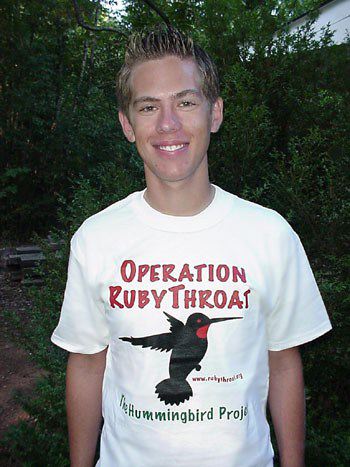
Need a Special Gift for a Want to make a If so, why not use our new handy-dandy on-line Google Checkout below to place your secure credit card order or become a Major Donor today? |
|
|
|
|
SPECIES BANDED THIS WEEK: * = New species for 2008 WEEKLY BANDING TOTAL 7 species 8 individuals YEARLY BANDING TOTAL (2008) 64 species 1,633 individuals 27-YEAR BANDING GRAND TOTAL (since 28 June 1982) 124 species 51,800 individuals
|
OTHER NATURE NOTES OF INTEREST
--After four weeks of steady and diverse fall migration at Hilton Pond Center, the bottom fell out this week and we trapped only eight birds from seven species (see list at left). Except for the two parulids--the Yellow-rumped Warbler that just arrived and may spend the winter, and the Black-throated Blue Warbler likely on its way south--these birds could be locally produced year-round residents being drawn toward our seed feeders as natural foods begin to wane. --For the first time since the early April 2008, we went all week without even seeing a Ruby-throated Hummingbird at the Center. Since our latest-ever date for a local RTHU is 18 October, we suspect it will be six months or so until we see another here at York. Guess we'll just have to go to Central America sometime soon for our usual midwinter "hummingbird fix"--or wait for a winter vagrant to appear.
|
|
PERSONAL NOTE
Thanks to community support, police have arrested one of two suspects. Woody is still battling for his life at Virginia Commonwealth University medical center and has been through numerous surgeries and procedures. If you know Woody--and even if you don't--please take a moment to send healing vibes his way in the hope his recovery will be swift and complete. |
|
|
|
|
(Back to Preceding Week; on to Next Week) Up to Top of Page Back to This Week at Hilton Pond Center Current Weather Conditions at Hilton Pond Center |
 You can also post questions for The Piedmont Naturalist |
Join the |
Search Engine for |
|
|
Online Dating Services

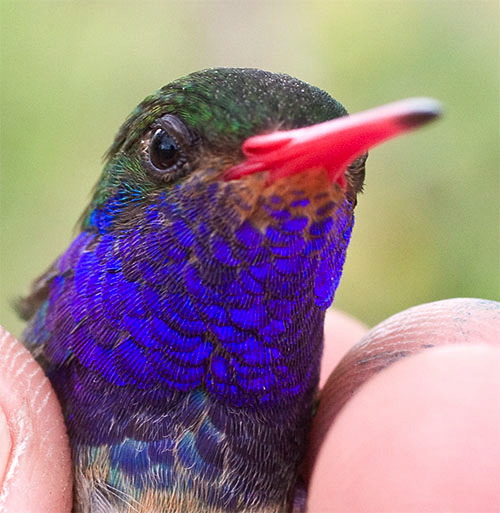
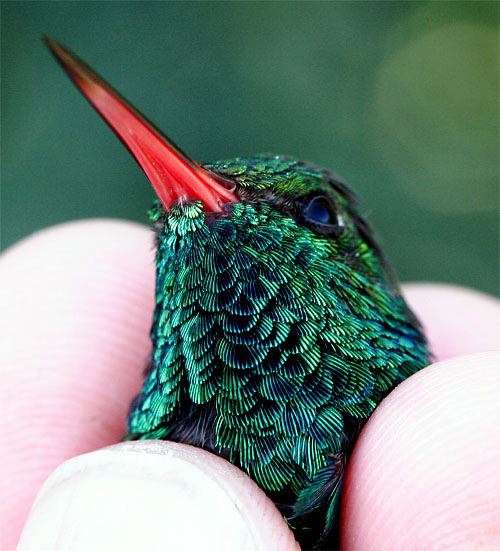

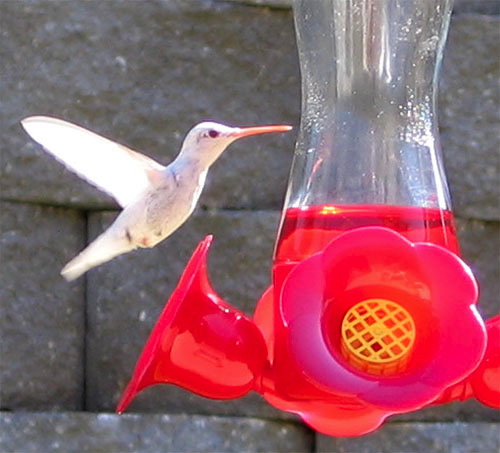
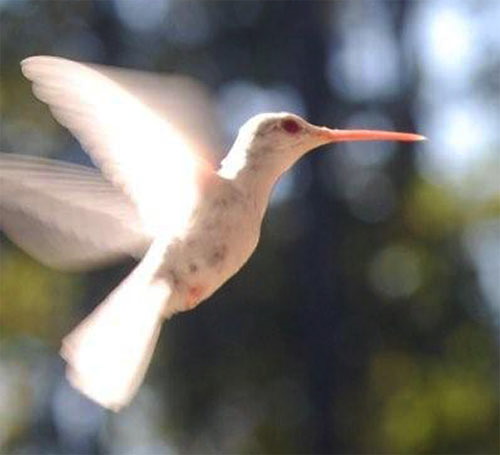

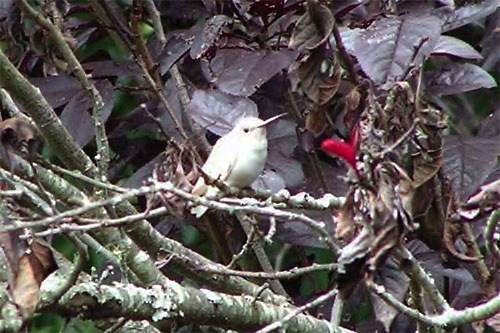
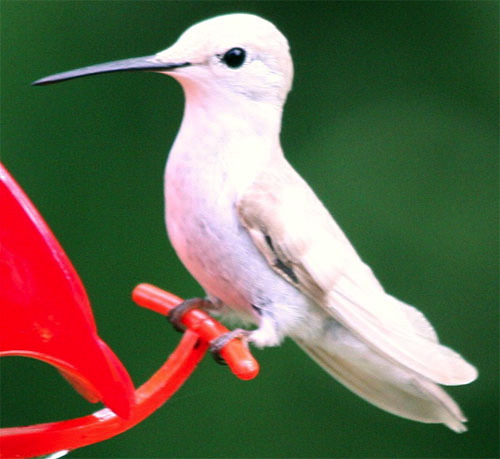
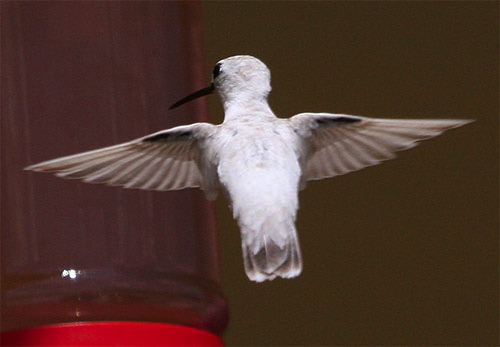

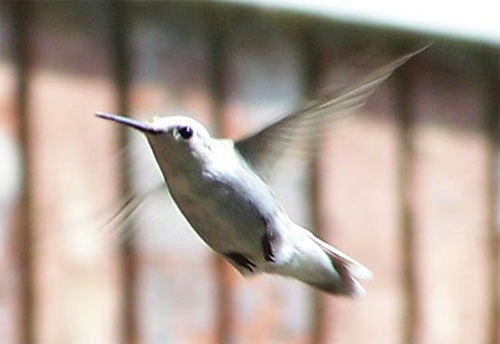

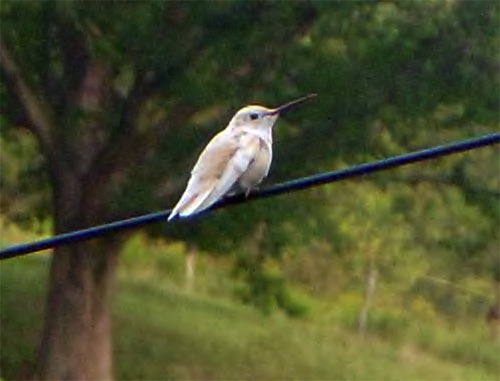
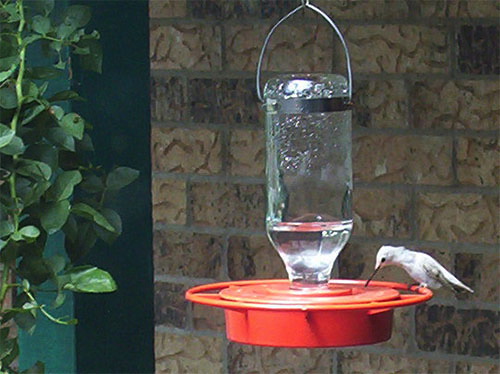


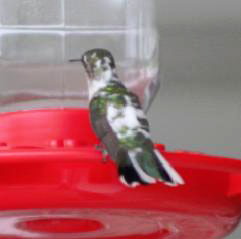 Jay's is a Ruby-throated Hummingbird while Susan's is a Black-chinned, but that's not what we think is REALLY unusual about her hummer. According to Susan, this is the second year in a row this pied Black-chinned Hummingbird has visited her feeders--something that, to our knowledge, has never been said about an albinistic or leucistic Ruby-throated Hummingbird. In fact, we know of only one report of an albino or leucisto of any hummer species that returned in a later year, and that was apparently a nonmigratory Anna's Hummingbird in California. (By the way, Susan had TWO pied Black-chinned Hummingbirds at her Arizona feeder in 2008, leading her to speculate they were mother and daughter from successive years.)
Jay's is a Ruby-throated Hummingbird while Susan's is a Black-chinned, but that's not what we think is REALLY unusual about her hummer. According to Susan, this is the second year in a row this pied Black-chinned Hummingbird has visited her feeders--something that, to our knowledge, has never been said about an albinistic or leucistic Ruby-throated Hummingbird. In fact, we know of only one report of an albino or leucisto of any hummer species that returned in a later year, and that was apparently a nonmigratory Anna's Hummingbird in California. (By the way, Susan had TWO pied Black-chinned Hummingbirds at her Arizona feeder in 2008, leading her to speculate they were mother and daughter from successive years.)  On top of that, being bright white in a mostly green world may make these rare hummers more easily taken by predators. And, since melanin is a structural pigment that adds strength to feathers, birds that lack it may have plumage that wears out quickly. It's always possible, of course, there have just been too few white hummingbirds banded to make any conclusions about their survivability, but we're guessing as eye-catching and awe-inspiring as they may be, albinos and leucistos are destined to live short lives. (Why else wouldn't folks see white hummers--adults--in spring?) We doubt this short-life phenomenon diminished Patti Livingston's astonishment in late August when a tan-and-white leucistic Ruby-throated Hummingbird (above left) came to visit her Ruleville MS home. Her leucisto's "red eye" is merely an artifact of the camnera flash.
On top of that, being bright white in a mostly green world may make these rare hummers more easily taken by predators. And, since melanin is a structural pigment that adds strength to feathers, birds that lack it may have plumage that wears out quickly. It's always possible, of course, there have just been too few white hummingbirds banded to make any conclusions about their survivability, but we're guessing as eye-catching and awe-inspiring as they may be, albinos and leucistos are destined to live short lives. (Why else wouldn't folks see white hummers--adults--in spring?) We doubt this short-life phenomenon diminished Patti Livingston's astonishment in late August when a tan-and-white leucistic Ruby-throated Hummingbird (above left) came to visit her Ruleville MS home. Her leucisto's "red eye" is merely an artifact of the camnera flash.

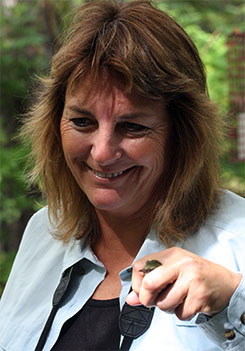
 Our dear and lifelong friend, Haywood Daniel McCallum Jr., was shot several times and wounded severely by robbers outside his home in Richmond VA on the evening of 11 October 2008. We have known kind-hearted Woody, a gifted and widely admired music teacher retired from Richmond schools, for almost 40 years--ever since 1969 when we were on "staph" and he was a delegate to West Virginia's prestigious National Youth Science Camp.
Our dear and lifelong friend, Haywood Daniel McCallum Jr., was shot several times and wounded severely by robbers outside his home in Richmond VA on the evening of 11 October 2008. We have known kind-hearted Woody, a gifted and widely admired music teacher retired from Richmond schools, for almost 40 years--ever since 1969 when we were on "staph" and he was a delegate to West Virginia's prestigious National Youth Science Camp. Oct 15 to Mar 15:
Oct 15 to Mar 15: